NAT 50.86% vs LAB
Incumbent MP
Paul Hutchison, since 2008. Previously Member for Port Waikato 1999-2008.
Geography
Southern outskirts of Auckland. Hunua lies entirely within the Auckland Region, but largely covers rural areas to the south and east of the Auckland urban area, as well as the town of Pukekohe.
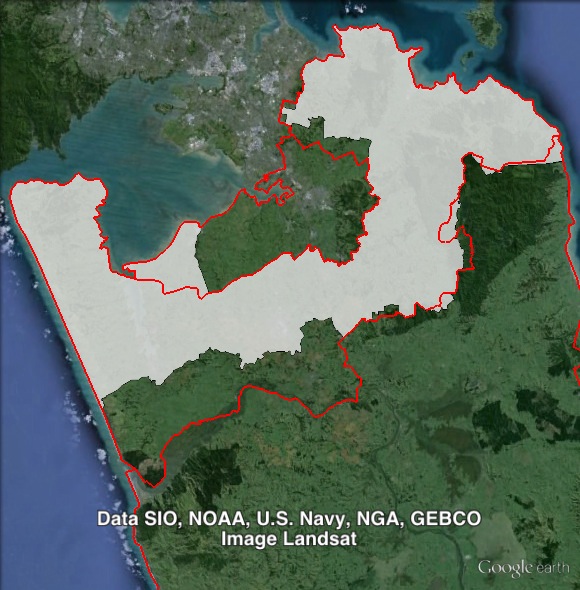
Redistribution
Hunua’s southern boundaries with Coromandel and Waikato were adjusted, with most changes being minor, and with a piece of territory in the south-west of the electorate transferred to Waikato. Hunua gained the area around Clarks Beach from the western end of Papakura, while losing areas at the other end of Papakura to Papakura, and a small area to Botany on the edge of the Auckland urban area. These changes increased the National margin from 48.8% to 50.9%.
History
The electorate of Hunua has existed in its current form only since 2008, although it previously existed from 1978 to 1984 and again from 1996 to 2002.
The seat at its first election in 1978 produced a remarkably close result which originally saw Labour’s Malcolm Douglas win the seat. A 1979 court decision overturned the result and gave the seat to Winston Peters of the National Party – who went on to found and lead New Zealand First in 1993.
Peters lost in 1981 to Labour’s Colin Moyle. Moyle had held other seats in eastern Auckland from 1963 to 1977, when he resigned from Parliament. Moyle continued in Parliament until 1990, in other seats after Hunua’s abolition in 1990.
National MP Warren Kyd, who had held other seats since 1987, won the restored Hunua electorate in 1996, and again in 1999. In 2002, the seat was abolished again, and he lost to Judith Collins for National preselection and retired.
Paul Hutchison won Hunua in 2008. Hutchison had held Port Waikato from 1999 to 2008. That seat was then abolished, and Hunua was restored covering some of the same territory.
Also in 2008, former Labour finance minister Roger Douglas returned to Parliament as an ACT list MP after running in Hunua. Douglas had helped form ACT in the 1990s. After one term in Parliament, he retired in 2011.
Hutchison was re-elected in Hunua in 2011.
Candidates
Sitting National MP Paul Hutchison is not running for re-election.
- Andrew Bayly (National #55)
- Ian Cummings (ACT #9)
- Neville Hudson (Conservative #19)
- Huia Mitchell (Democrats #21)
- Tom Phillips (Māori #14)
- Jon Reeves (New Zealand First #15)
- Arena Williams (Labour #40)
Assessment
Hunua is a very safe National seat.
2011 election results
| Electorate Votes | Party Votes | ||||||||
| Candidate | Party | Votes | % | Swing | Redist | Votes | % | Swing | Redist |
| Paul Hutchison | National | 22,563 | 65.59 | +1.18 | 66.76 | 22,161 | 62.58 | +1.94 | 63.44 |
| Richard Hills | Labour | 5,766 | 16.76 | -1.05 | 15.90 | 5,705 | 16.11 | -3.60 | 15.27 |
| Charmaine Watts | Green | 2,576 | 7.49 | +3.01 | 7.46 | 2,438 | 6.88 | +3.52 | 6.89 |
| Doug Nabbs | New Zealand First | 1,405 | 4.08 | +1.15 | 4.02 | 2,626 | 7.42 | +3.04 | 7.27 |
| Kevin Campbell | Conservative | 1,373 | 3.99 | +3.99 | 3.84 | 1,320 | 3.73 | +3.73 | 3.82 |
| Ian Cummings | ACT | 440 | 1.28 | -7.74 | 1.28 | 515 | 1.45 | -6.79 | 1.45 |
| Thomas Phillips | Māori | 194 | 0.56 | +0.56 | 0.52 | 188 | 0.53 | -0.01 | 0.55 |
| Huia Mitchell | Democrats | 81 | 0.24 | +0.24 | 0.23 | 30 | 0.08 | +0.06 | 0.11 |
| United Future | 170 | 0.48 | -0.34 | 0.50 | |||||
| Legalise Cannabis | 154 | 0.43 | +0.11 | 0.44 | |||||
| Mana | 75 | 0.21 | +0.21 | 0.20 | |||||
| Libertarianz | 25 | 0.07 | +0.04 | 0.05 | |||||
| Alliance | 4 | 0.01 | -0.03 | 0.01 | |||||
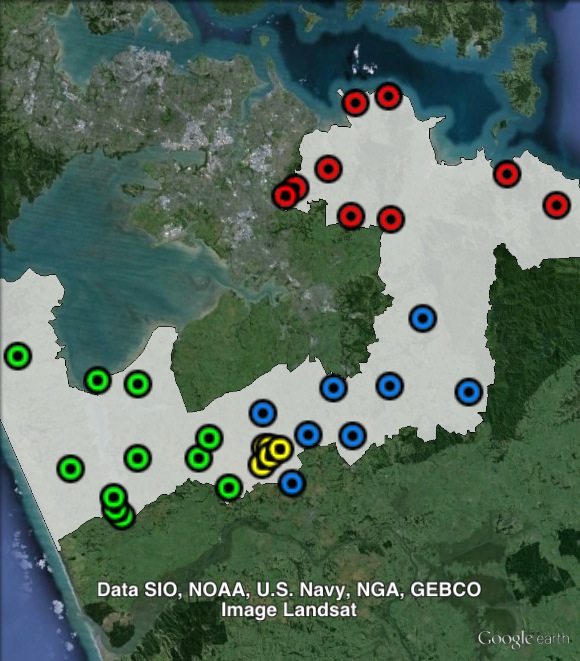
Booth breakdown
Booths in Hunua have been divided into four areas. The largest town in the electorate, Pukekohe, includes five polling places that have been grouped together.
The other three areas have been grouped as “West” (west of Pukekohe), “North” (north of Papakura) and “Central” in between.
The National Party won large majorities in all four areas, ranging from 57% to 69% on the party vote and 60% to 73% on the electorate vote.
The Labour Party polled much lower, with a vote ranging from 9-10% in Central to 19-21% in Pukekohe.
The New Zealand First vote and the Green Party vote both peaked in the West.
| Voter group | Electorate votes | Party votes | Total | % of votes | |||||
| NAT | LAB | GRN | NAT | LAB | NZF | GRN | |||
| West | 63.74 | 16.60 | 8.68 | 60.81 | 14.75 | 9.08 | 7.57 | 7,532 | 23.86 |
| Pukekohe | 60.37 | 20.77 | 6.68 | 57.20 | 19.82 | 8.72 | 6.47 | 6,561 | 20.78 |
| North | 72.17 | 13.53 | 7.51 | 69.04 | 13.41 | 5.06 | 6.58 | 6,535 | 20.70 |
| Central | 73.42 | 10.16 | 6.40 | 69.32 | 9.43 | 6.45 | 6.98 | 3,751 | 11.88 |
| Other votes | 67.34 | 15.86 | 7.42 | 63.78 | 16.30 | 6.51 | 6.78 | 7,194 | 22.79 |
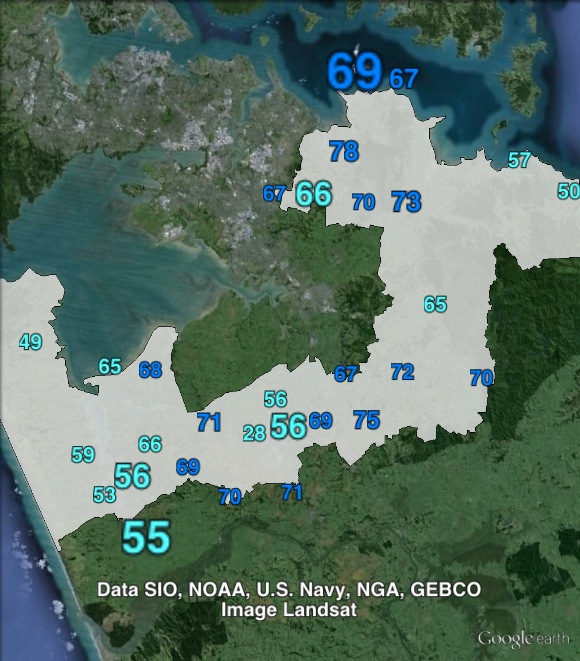
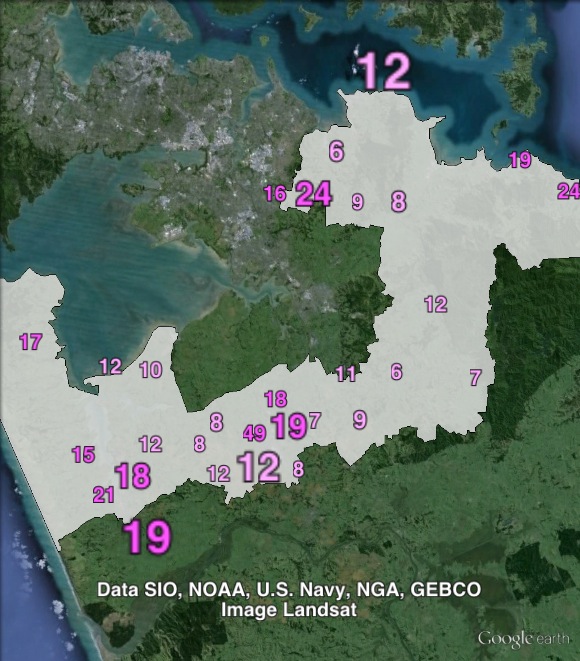
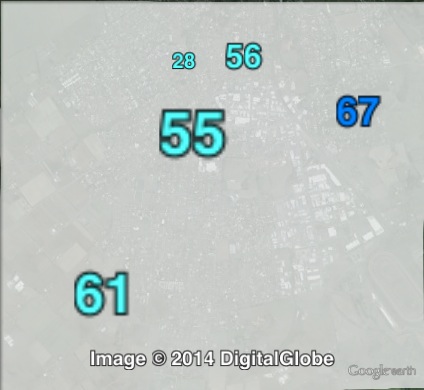
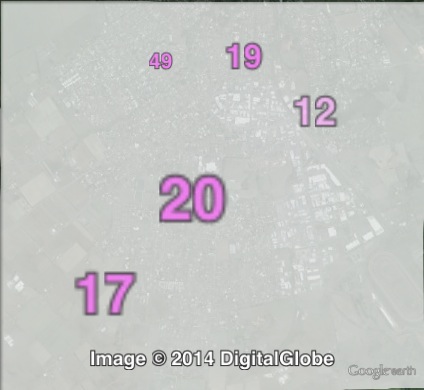


There’s another one of those weirdly strong Labour booths – 49% in Pukekohe, 30% better than just about anywhere else in the electorate. There’s a few of those scattered around Auckland – check out Tamaki, Botany and Papakura.
Hi,
Can you please correct the spelling of my name to Jon, not John? Also please find the link to my New Zealand First facebook page.
Regards,
Jon Reeves
Hunua Candidate 2014 General Election
New Zealand First
Hi Jon,
I’ve added the link and corrected the spelling of your name. You should also try to get it fixed on this page, which is where I got the candidate information: http://en.wikipedia.org/wiki/Candidates_in_the_New_Zealand_general_election_2014_by_electorate
Guessing ultra-strong Labour booths are particular ethnic group concentrations – Pacific islanders? Even if Maori are voting in Maori seats there would be some impact from them in encouraging a local group identity?
You see a very strong divide between the Labour electorates in the south-east and the National electorates in the east – I think there’s quite a lot of Maori who vote in the general electorates, as well as similar communities like Pacific Islanders.
South Auckland is famous even outside NZ, thanks to Once Were Warriors. That would explain an area full of similarly rock solid Labour booths (Otara, Cabramatta, wherever), but the single blips in otherwise safe National territory are still weird. There’s a few in Australia (Cherbourg in Qld, Toomelah in NSW) associated with Aboriginal communities, but they don’t tend to happen in suburbia.
That could be interesting to look into. Compare the percentage of Maori voters / general voters by booth (or even by electorate) with the actual percentage of Maori from census data, if that exists / is gettable.
Aand that just gave me yet another question: how do ballot booths operate with two different rolls? That could get messy if there was a general box next to a Maori box and votes ended up in the wrong ones.
Pukekohe is a small urban centre with a population of about 10,000 that has some particularly poor suburbs, otherwise the rest of the electorate is pretty much rural. Thus the reason for the blip.
“Aand that just gave me yet another question: how do ballot booths operate with two different rolls? That could get messy if there was a general box next to a Maori box and votes ended up in the wrong ones.”
They’re clearly labelled, and there’s several support staff to tell you which box you need to put your vote in.
Even if that failed, I’m sure they’d just pass the ballots on to the right box as the candidate vote obviously would be wrong.
Yeah it doesn’t seem difficult for a polling place to have two separate rolls and two separate ballots. It’s quite common in Australia that a polling place covers more than one electorate – they just have two separate queues and clearly marked boxes.
Also, the party vote ballot and the electorate vote ballot are on the same physical piece of paper so if the paper goes in the wrong box it wouldn’t be hard to sort it out correctly.
@Shazzadude, you are partly true about Pukekohe, but there are a number of booths in the town and only one of them is strongly pro-Labour. You can see in the above table that there are five booths in the electorate and overall National won 60% of the electorate vote in the area and 57% of the party vote.